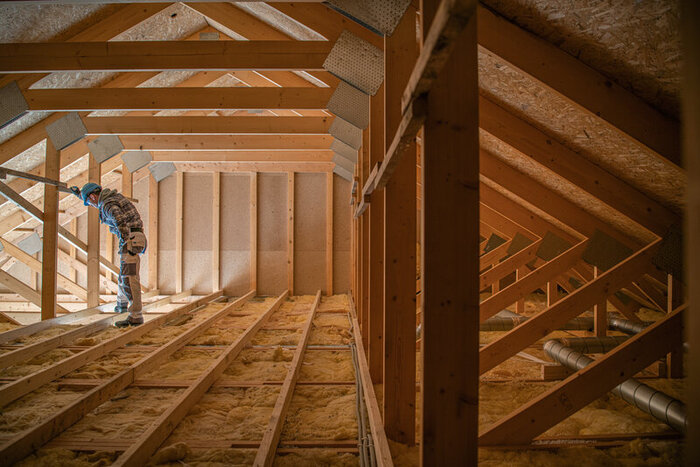🌡️ How Attic Temperature Affects Your Comfort

When it comes to maintaining a comfortable home, many homeowners overlook the crucial role of the attic temperature. While it might seem like an isolated space, the temperature in your attic directly impacts the comfort level of the entire home. Whether it’s summer or winter, fluctuating attic climate can affect not just the comfort of individual rooms, but also your energy bills and overall home efficiency.
🔥 How High Attic Temperatures Affect Your Home’s Comfort
During the warmer months, attics can become extremely hot due to the direct exposure to sunlight. This trapped heat can lead to several issues, including elevated indoor temperatures throughout the home. Even if the rest of the house remains cool, the heat radiating from the attic can force your air conditioning system to work harder, resulting in higher utility costs.
The primary problem is that heat rises. As the air in your attic becomes warmer, it can seep into the rooms below, causing uneven room temperatures. Rooms directly beneath the attic are usually the first to feel the effects of this heat. For example, bedrooms or living spaces on the upper floors of a home can feel sweltering, making it uncomfortable for residents, even when the thermostat is set at a reasonable temperature.
Additionally, excessive attic heat can have a significant impact on your home’s HVAC system. Overworking the air conditioning unit to counteract the heat from the attic can result in mechanical stress, reducing the lifespan of the unit. It also leads to frequent repairs and, in some cases, the need for an early replacement of the system.
❄️ The Impact of Cold Attic Warmth
On the flip side, during the winter months, attics can become dangerously cold. This cold air, if not properly sealed, can enter the living spaces of your home and cause your heating system to work overtime. The cold from the attic can lead to a noticeable drop in temperature in the upper floors, leaving them chilly and uncomfortable, while lower floors may remain warmer.
In the absence of proper insulation or ventilation, the cold can also lead to issues like frozen pipes, ice dams, and other damage to the roof structure. Additionally, the sudden temperature difference between the attic and the rooms below can put unnecessary strain on your heating system, leading to spikes in energy costs.
💸 HVAC Strain and Energy Bills
The strain on your HVAC system is one of the most notable consequences of improper attic climate temperature regulation. Whether the attic is too hot or too cold, your HVAC system will work harder to maintain an even temperature throughout your home. This increased workload is directly tied to your monthly power expenses, as more energy is required to heat or cool the air inside.
In hot weather, air conditioners often run continuously in an attempt to cool the home, while in winter, heating systems have to fight against the cold temperatures entering from the attic. Both situations cause the system to operate inefficiently, leading to higher energy consumption and, ultimately, inflated utility costs.
🧱 Insulation: A Solution to Temperature Extremes
Proper insulation is one of the most effective ways to combat loft climate extremes. Insulating your attic helps keep heat from escaping during the winter and prevents heat from entering during the summer. Insulation materials, such as blown-in cellulose, fiberglass batt, or spray foam, can effectively regulate temperature fluctuations, reducing the workload on your HVAC system and contributing to a more consistent indoor temperature.
By preventing the attic from overheating in the summer, insulation can keep the rest of your home cooler, which can reduce the need for air conditioning. During winter, insulation helps retain heat in your home, preventing heat loss through the attic and ensuring that your heating system doesn’t have to work as hard.
🔧 Sealing Air Leaks
In addition to insulation, sealing any gaps or cracks in your attic is another essential step in regulating attic conditions. Air leaks can allow cold drafts in the winter or warm air in the summer to enter your living spaces, causing discomfort and reducing the effectiveness of your HVAC system.
Simple solutions, such as sealing gaps around ducts, vents, and chimneys, can significantly reduce the unwanted transfer of hot or cold air from the attic. Ensuring that your attic is properly sealed will also help prevent pests from making their way into your home, creating an additional benefit for your overall home health.
💨 Proper Ventilation for Balanced Temperature
Another key element in managing loft climate is ventilation. Proper ventilation allows air to circulate, helping to release hot air that accumulates in the summer and allowing cool air to enter during the winter. Without adequate ventilation, hot air can get trapped, leading to the same problems as a poorly insulated attic, such as uneven temperatures and high energy expenses.
Venting systems, such as ridge vents, soffit vents, or gable vents, can help maintain a balance of airflow in the attic. This reduces the risk of excess heat or cold accumulating and can prolong the life of your roof and insulation by preventing moisture buildup.
🛠️ Monitoring and Maintenance
Regular monitoring of attic conditions is essential for maintaining long-term comfort and efficiency. Over time, insulation can degrade, ventilation systems can become blocked, and air leaks may form. Conducting routine checks of your attic and making necessary repairs can ensure that it continues to perform optimally.
Keeping an eye on your roof area temperature through the changing seasons can alert you to any inefficiencies that may be affecting your comfort and energy costs. A simple attic inspection to check for air leaks, moisture, or inadequate insulation could be the key to reducing unnecessary strain on your HVAC system.
🌬️ Regulating Attic Climate for Year-Round Comfort

The temperature in your attic plays a crucial role in maintaining a comfortable living environment. Both excessive heat in summer and extreme cold in winter can cause discomfort and lead to higher energy costs. However, through proper insulation, sealing, and ventilation, you can regulate attic warmth and improve the overall efficiency of your home.
By addressing these issues, you can enjoy a more comfortable, energy-efficient living space throughout the year.
Ensuring that your attic is well-maintained, properly insulated, and adequately ventilated will not only keep your home comfortable but also save you money in the long run. Regularly checking and maintaining these systems is key to preventing larger issues and reducing strain on your HVAC system, ultimately lowering power bills and improving the overall comfort of your home. Partnering with experts like Attic Fanatics USA ensures that your attic is optimized for maximum comfort and efficiency, offering you peace of mind and long-term savings.







